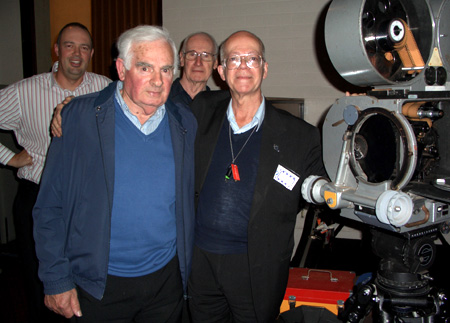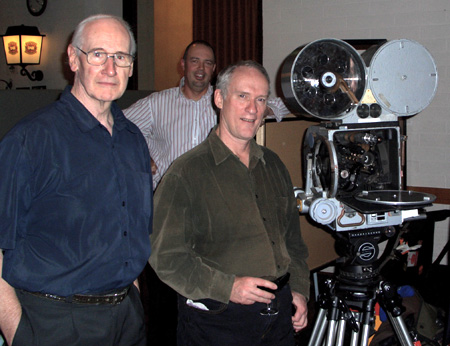My trip to Melbourne |
Read more at in70mm.com The 70mm Newsletter |
| Written by: John Steven Lasher, Kinopanorama Widescreen Preservation Association Incorporated | Date: 27.06.2010 |
 Cliff
Williamson is one of the oldest surviving Cinerama projectionists in
Australia. He worked at the Plaza Cinema, Melbourne, where he screened all
of the Cinerama (and Cinemiracle) 3-strip and 70mm films from 1958 to the
very end. Seen on image are:
David Kilderry. Cliff Williamson, Phil O’Kane and John Steven Lasher. Copyright (c) 2010 Kinopanorama Widescreen Preservation Association. All Rights Reserved. Cliff
Williamson is one of the oldest surviving Cinerama projectionists in
Australia. He worked at the Plaza Cinema, Melbourne, where he screened all
of the Cinerama (and Cinemiracle) 3-strip and 70mm films from 1958 to the
very end. Seen on image are:
David Kilderry. Cliff Williamson, Phil O’Kane and John Steven Lasher. Copyright (c) 2010 Kinopanorama Widescreen Preservation Association. All Rights Reserved.My trip to Melbourne was three-fold. First on my agenda (Tuesday, 22 June) was to visit The Australian Centre for the Moving Image (A C M I), and, in particular, to view their permanent exhibition, "Screen Worlds: The Story of Film, Television and Digital Culture". The exhibit covers just about everything relating to 'the moving image'. About the only thing missing was any pertinent information about the various widescreen cinema formats. Also, no info on the current 3D craze. But, then, I suspect that either Samsung or Sony will provide product for a future exhibit. The Tim Burton exhibition was being set-up on the day, but there was not enough in the way of images to attract my attention. Mr Burton officially opened the exhibit of his works on Thursday. Wednesday was set aside for the Telecine transfers of the Kinopanorama footage of "Grand Ridge Road" [still a working title, since we have yet to actually film in that particular location in Victoria. The actual footage shot by Bruce MacNaughton, our DP, was in The Dandenong Ranges, located less than a one hour drive from Melbourne]. Bruce and I arrived at Digital Pictures well before the time booked for our session. The transfers were a learning experience for all concerned, as nothing like this [ie. Kinopanorama or any other 3-strip format] had ever been attempted before in Australia. It took Bruce quite a while to convince Dee, our colourist, that the 3-panels would match at the edges if we graded the centre panel and then transferred the left and right panels with the same grading. She'd already done a grade of her own -- taking a shot of each panel and grading each independently. This, of course, was wrong. As Bruce had photographed a gray card for each panel at the beginning of each shot, panning the camera from one film panel to the other under uniform lighting conditions, it was possible to achieve an accurate reference for the overall panoramic images. The equipment being used for the transfers would not allow for any "offsets" as one would employ in RGB grading of film. So, it was back to the beginning. Each panel had to be re-graded to match the grading of the centre 'B' panel. Very time consuming. [Incidentally, the films are imaged on 8-perf horizontal equipment. Think VistaVision. Of course, only 6-perfs for Kinopanorama are used. Greg will rotate each panel 90-degrees in order to 'stitch' the tree-panels to form a single 2.55:1 letter-box image]. | More in 70mm reading: Kinopanorama Films 3 strip shoot in the Melbourne Hills Kinopanorama Camera John Lashers' Kinopanorama of 1995 Internet link: The Kinopanorama Experience The Kinopanorama Widescreen Preservation Association The Australian Centre for the Moving Image |
 Kinopanorama
camera exhibited at Australian Society of Cinema Pioneers. Seen in
picture are: Phil O’Kane, David Kilderry and Steve Buckingham. All
gentlemen pictured are current or former projectionists with 70mm
experience. Copyright (c) 2010 Kinopanorama Widescreen Preservation Association. All Rights Reserved. Kinopanorama
camera exhibited at Australian Society of Cinema Pioneers. Seen in
picture are: Phil O’Kane, David Kilderry and Steve Buckingham. All
gentlemen pictured are current or former projectionists with 70mm
experience. Copyright (c) 2010 Kinopanorama Widescreen Preservation Association. All Rights Reserved.Bruce, who had been in regular contact with Greg Kimble over the past several days, adhered to his instructions. After the film was transferred again the results included some colour lift. Greg's response in his email to Bruce, which I quote, was "your instinct was absolutely correct. Grading each panel independently is the WORST (caps are Greg's) thing the colourist could do. This is why transferring Cinerama/Kinopanorama is such a pain and perplexes even the best colourist. [...] So high marks to you." The telecine's were transferred to a hard-drive over the weekend. I purchased one with a USB (should have had Firewire), unfortunately. So, it took over 5-hours to transfer roughly 12-minutes (4-minutes per panel) overnight. The transfers will be couriered to Greg around 1st July. From there on it will be in his more than capable hands. Thursday was set aside for the quarterly meeting of The Society of Australian Cinema Pioneers in the Melbourne suburb of Prahran. I travelled there by tram. Over 80 members attended. The president of the Society arranged for a screening of "The Cinerama Adventure". Unfortunately, due to time constraints, only 40% of the DVD footage was actually shown. I was invited to give a talk about the restoration of the Kinopanorama camera, the recent filming in the Dandenongs, the telecine work, plans for a future cinema, and some other bits of information. My talk was well received. The camera attracted plenty of attention. Many questions were asked about the similarity between Kinopanorama and Cinerama, not only in filming but also how the finished film is exhbiited. The members were, after all, mostly current (or former) projectionists. All in all, most worth while week on the part of all concerned. The only thing to don't look forward to is the Tax Invoice from Digital Pictures or, for that matter, the expense to courier the transfers ex Melbourne to Los Angeles. But, that's the film business, is it not? | |
| Go: back - top - back issues - news index Updated 22-01-25 |
